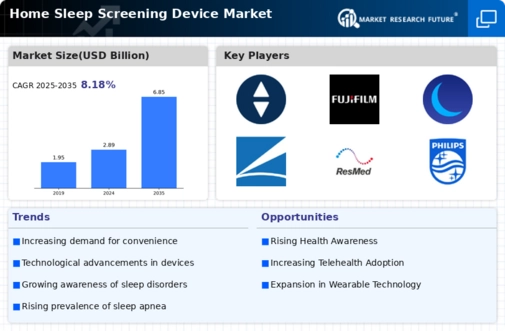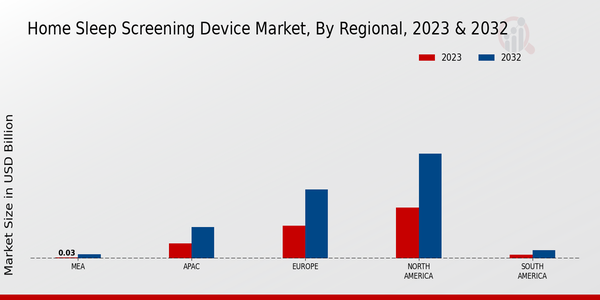Market Growth Projections
The Global Home Sleep Screening Device Market Industry is on a promising growth trajectory, with projections indicating a market value of 2.89 USD Billion in 2024, expected to reach 6.85 USD Billion by 2035. This growth reflects a compound annual growth rate (CAGR) of 8.16% from 2025 to 2035. Such figures suggest a robust demand for home sleep screening devices, driven by various factors including technological advancements, increased awareness of sleep health, and the rising prevalence of sleep disorders. The market's expansion is indicative of a broader trend towards personalized healthcare solutions.
Growing Geriatric Population
The aging population worldwide is a significant driver of the Global Home Sleep Screening Device Market Industry. Older adults are more susceptible to sleep disorders, necessitating effective monitoring solutions. As the geriatric demographic continues to expand, the demand for home sleep screening devices is expected to rise correspondingly. This trend is underscored by the increasing recognition of the need for tailored healthcare solutions for seniors, who often prefer the convenience of home-based monitoring. Consequently, the market is likely to experience substantial growth as it caters to the unique needs of this population segment.
Increased Awareness of Sleep Health
There is a growing recognition of the importance of sleep health among the general population, which propels the demand for home sleep screening devices. Public health campaigns and educational initiatives emphasize the link between sleep quality and overall health, leading to increased consumer interest in sleep monitoring solutions. The Global Home Sleep Screening Device Market Industry is poised to capitalize on this trend, as more individuals seek to understand and improve their sleep habits. This heightened awareness may contribute to the market's projected growth, as consumers invest in devices that facilitate better sleep management.
Shift Towards Preventive Healthcare
The global healthcare landscape is increasingly shifting towards preventive care, with individuals seeking proactive measures to maintain their health. Home sleep screening devices align with this trend by enabling users to monitor their sleep patterns and identify potential issues before they escalate. The Global Home Sleep Screening Device Market Industry stands to benefit from this paradigm shift, as consumers prioritize early detection and intervention strategies. This proactive approach to health management is likely to drive demand for home sleep screening solutions, contributing to the market's anticipated growth trajectory in the coming years.
Rising Prevalence of Sleep Disorders
The increasing incidence of sleep disorders globally drives the demand for home sleep screening devices. Conditions such as sleep apnea, insomnia, and restless leg syndrome affect millions, leading to a heightened awareness of sleep health. The Global Home Sleep Screening Device Market Industry is responding to this trend, with an estimated market value of 2.89 USD Billion in 2024, projected to grow to 6.85 USD Billion by 2035. This growth reflects a compound annual growth rate (CAGR) of 8.16% from 2025 to 2035, indicating a robust market expansion fueled by the need for effective sleep disorder management.
Technological Advancements in Sleep Monitoring
Innovations in technology significantly enhance the capabilities of home sleep screening devices, making them more accessible and user-friendly. Features such as smartphone integration, advanced sensors, and artificial intelligence algorithms improve the accuracy of sleep assessments. The Global Home Sleep Screening Device Market Industry benefits from these advancements, as they attract a broader consumer base interested in monitoring their sleep patterns. As technology continues to evolve, it is likely that the market will see an influx of new products, further driving growth and adoption among consumers seeking personalized sleep solutions.





















Leave a Comment